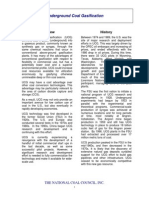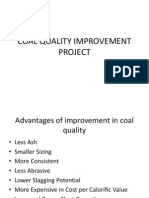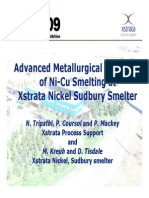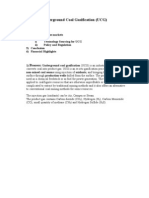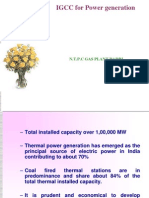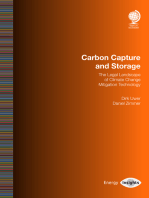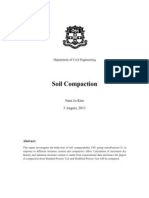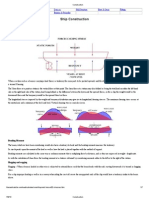Eskom Develops UCG Technology Project
Eskom Develops UCG Technology Project
Uploaded by
pngoc8Copyright:
Available Formats
Eskom Develops UCG Technology Project
Eskom Develops UCG Technology Project
Uploaded by
pngoc8Original Title
Copyright
Available Formats
Share this document
Did you find this document useful?
Is this content inappropriate?
Copyright:
Available Formats
Eskom Develops UCG Technology Project
Eskom Develops UCG Technology Project
Uploaded by
pngoc8Copyright:
Available Formats
Eskom Develops UCG Technology Project
Chris Gross Mark Van der Riet
21st June 2007 Houston, USA
SOUTH AFRICAN COAL
Eskom Generated Electricity
2006 : 221216 GWh Net
Coal 93.05%
Gas turbine 0.04% Nuclear 5.10%
Hydro 0.52%
Pumped storage 1.30%
om sk E
G UC
ESKOM UNDERGROUND COAL GASIFICATION PILOT PROJECT
Rationale for Eskoms stakeholding
Opens an opportunity for more rapid deployment of new capacity Showcases a cleaner coal technology plant Introduces potential CDM credits Allows more efficienct utilisation of coal resources Creates a potential for a new petrochemical entity Extends RSA coal reserves, by opening up presently unminable resources, which have a broader geographic availability that at present.
Existing plant age
Eskom's Installed profile
Dashed line = Approved peak demand + 20% Reserve Margin
55 45000
60
65
70
75
80
85
90
95
00
Now 05
10
15
20
25
30
35
40
40000
Grootvlei
Komati
Majuba 4-6
35000
Camden Cahora Bassa Zesco
Majuba 1-3 30000 Megawatt Installed Kendal
Palmiet
25000
Matimba Lethabo
20000
Tutuka Koeberg
15000
Vanderkloof Port Rex Acacia
Drakensberg
Duvha Matla Arnot Kriel
HF Verwoerd
10000
5000
Grootvlei Camden
Ingagane Highveld Salt River Taaibos Wilge
Komati
0 55 60 65
Hendrina 80 85 90 95 Year 00 05 10 15 20 25 30 35 40
70
75
Most stations at mid life refurbishment point.
Long-term energy forecast
Capacity outlook 2005 to 2024
Build base-load plants Build open cycle gas turbine plants (peaking) Build pumped storage plants (peaking) Return to service (mothballed plants) Existing system (Eskom and non-Eskom) Total imports (firm capacity from Cahora Bassa)
Maximum demand Based on a 6% GDP growth, a high 4,4% growth scenario in demand for electricity before demand-side management Total capacity required to maintain 15% net reserve margin on moderate forecast Forecast moderate national peak demand before demand side management Moderate peak demand after demand-side management
Rationale for Eskoms stakeholding
Opens an opportunity for more rapid deployment of new capacity Showcases a cleaner coal technology plant Introduces potential CDM credits Allows more efficienct utilisation of coal resources Creates a potential for a new petrochemical entity Extends RSA coal reserves, by opening up presently unminable resources, which have a broader geographic availability that at present.
UCG-IGCC Comparative Emissions
1000 900 800 4.0 3.5 3.0 2.5 2.0 1.5 1.0 0.5 0.0 Conv PF CO2 Super PF NOx Conv IGCC UCG-IGCC Nat Gas CC SOx Particulates
700 600 500 400 300 200 100 0
Ref : Australian ACARP LCA study, Case Study B20, June 2002
The only cleaner coal-based technology is the proposed ultra-supercritical PF
NOx/SOx/Particulates kg/MWh net
CO2 kg/MWh net
Rationale for Eskoms stakeholding
Opens an opportunity for more rapid deployment of new capacity Showcases a cleaner coal technology plant Introduces potential CDM credits Allows more efficienct utilisation of coal resources Creates a potential for a new petrochemical entity Extends RSA coal reserves, by opening up presently unminable resources, which have a broader geographic availability that at present.
Resource Utilisation Efficiency
33% of coal resource utilised Thermal Efficiency
33
Mining Efficiency
66
0%
New Ultra-supercritical or Conventional IGCC with Longwall U/G Mine 36% of coal resource utilised
100%
Thermal Efficiency
36
Chemical Efficiency
71
Mining Efficiency
95
0%
Thermal Efficiency
UCG-IGCC 0.5% of resource utilised
Extraction Efficiency
100%
13
25
50
0%
CCGT with CBM
100%
Rationale for Eskoms stakeholding
Opens an opportunity for more rapid deployment of new capacity Showcases a cleaner coal technology plant Introduces potential CDM credits Allows more efficienct utilisation of coal resources Creates a potential for a new petrochemical entity Extends RSA coal reserves, by opening up presently unminable resources, which have a broader geographic availability that at present.
Rationale for Eskoms stakeholding
Opens an opportunity for more rapid deployment of new capacity Showcases a cleaner coal technology plant Introduces potential CDM credits Allows more efficienct utilisation of coal resources Creates a potential for a new petrochemical entity Extends RSA coal reserves, by opening up presently unminable resources, which have a broader geographic availability than at present.
Eskoms UCG Routemap
UCG technology potential noted - April 2001 Ergo Exergy Technologies Inc. (Canada) contracted in Scoping study - Nov 2002, highlighted potential at Majuba colliery Pre-feasibility study - Dec 2003, confirmed Majuba potential Detailed site characterisation study - July 2005, confirmed the potential 20th January 2007 Eskom commissioned a 3000 Nm3/h pilot plant on Majuba coalfield 31st May 2007 first electricity generated from UCG gas at Majuba
Events since Zeus UCG Workshop 2006
Eskom UCG Research Site
Outer Water Sampling Zone Research Zone
Inner Water Sampling Zone
Production Area
Directional Hole
Majuba UCG flare 20 Jan 2007
Majuba UCG electricity 31 May 2007
The first electricity from Majuba UCG gas was generated at 15:00 on 31st May 2007. This marks the first new electricity generation from UCG gas since 1958, in Angren, Uzbekistan. The 100 kWe diesel engine generator has been converted to run on a maximum of 80% UCG gas, with 20% diesel. The diesel is required to lubricate the engine internals.
100 kWe generator starting up on UCG gas
UCG Pilot Plant Challenges
Geological setting dolorites & schedule impact Insufficient geological & hydrogeological exploration data Unique products, due to unique coal and geological setting Equipment leadtimes Cost escalation & time creep Lengthly analytical service setup Surface plant technical difficulties and maintenance Energy efficiency (specifically diesel)
NOTE : The UCG process has remained robust throughout
Present UCG Activities
Accelerating process development Optimising the pilot plant operations Developing co-firing with coal into Majuba Power Station boilers Skills development & technology transfer Optimising, planning, detailed engineering & costing of the next phases Research into challenges : Dolorites & drilling problems Coal seam drying Well linkage Environmental impacts Heat & mass balances Materials
Dolorite Intrusions
ESKOM UNDERGROUND COAL GASIFICATION COMMERCIALISATION
Eskom UCG Development Path
Timescale
01/2007
05/2008
12/2008
12/2010
08/2011
Phase 1A-1 3,000 Nm3/h 6 MWth flare
Phase 1B 70,000 Nm3/h 28 MWe cofire
Phase 2 125,000 Nm3/h 25 MWe cofire
Phase 3 625,000 Nm3/h 250 MWe cofire
Phase 4 630,000 Nm3/h 350 MWe IGCC
RD&D
Comm
EIA
Engineering & Investment
Procurement Commercial 3,700,000 Nm3/h 2100 MWe IGCC
Construction
Co-firing & 350 MW UCG-CCGT
Compressor Plant
450 000 Nm3/h Air
Fuel Solution
Gas Treatment Plant & Flare
630,000 Nm3/h Gas
UCG Module
125,000 Nm3/h Gas
Majuba P/S
UCG Module
125,000 Nm3/h Gas
UCG Module
125,000 Nm3/h Gas
UCG Module
125,000 Nm3/h Gas
Final Gas Treatment - GT
630,000 Nm3/h Gas
Gas Compressors
2 x 315 000 Nm3/h Gas
UCG Module
125,000 Nm3/h Gas
Capacity Solution
350 MWe IGCC
Thank You & Acknowledgements
Eskom Resources & Strategy - ERID Eskom Generation - Primary Energy & Technology Majuba Power Station UCG Team EON Consulting Servies Ergo Exergy Inc. Specialist consultants
You might also like
- Microwaves For Coal Quality Improvement: The Drycol ProjectDocument12 pagesMicrowaves For Coal Quality Improvement: The Drycol ProjectlaurosaitoNo ratings yet
- 2development of 900 MW Coal-Fired Generating UnitsDocument8 pages2development of 900 MW Coal-Fired Generating Unitsrajum650100% (1)
- Phase Out News MX-OnE 5Document6 pagesPhase Out News MX-OnE 5zeljko_pavicevic82No ratings yet
- Connell Australia Activity1Document19 pagesConnell Australia Activity1tassili17No ratings yet
- Eskom OCGTDocument3 pagesEskom OCGTjanetNo ratings yet
- Presentation On Ultra Mega & Super Critical Projects Organized by Ficci & Mop May 2006Document19 pagesPresentation On Ultra Mega & Super Critical Projects Organized by Ficci & Mop May 2006ramnadh803181No ratings yet
- Mark VD RietDocument21 pagesMark VD Rietsuharyanto antoNo ratings yet
- Underground Coal GasificationDocument4 pagesUnderground Coal Gasificationikatpar100% (1)
- Slide UCG HayDocument23 pagesSlide UCG HayVăn Đại - BKHNNo ratings yet
- Bruce Hill - Catf Wy Eori Coal Trans SlidesDocument49 pagesBruce Hill - Catf Wy Eori Coal Trans SlidesManajemen Gas UI 2018No ratings yet
- National Thermal Power Corporation Dadri (Ghaziabad)Document24 pagesNational Thermal Power Corporation Dadri (Ghaziabad)Vaisakh1070No ratings yet
- Role of Nuclear Power in India'S Power-MixDocument19 pagesRole of Nuclear Power in India'S Power-MixsureshNo ratings yet
- Economics of Power Generation With UCGDocument67 pagesEconomics of Power Generation With UCGVăn Đại - BKHNNo ratings yet
- Review Paper On Ultra Supercritical Power Plants Full Length PaperDocument7 pagesReview Paper On Ultra Supercritical Power Plants Full Length PaperAtul NegiNo ratings yet
- Dryshow 201007Document0 pagesDryshow 2010071mmahoneyNo ratings yet
- Project228 4pDocument4 pagesProject228 4plemeitNo ratings yet
- BoilersDocument37 pagesBoilersSumaira KhanNo ratings yet
- Oxyfuel Combustion: R&D ActivitiesDocument21 pagesOxyfuel Combustion: R&D ActivitiesPablo Cadena100% (1)
- Power Plant Optimization Demonstration Projects: Topical Report Number 25 September 2007Document28 pagesPower Plant Optimization Demonstration Projects: Topical Report Number 25 September 2007Nayan MannaNo ratings yet
- Presentation ON Indian Power Sector GHG Reduction StrategyDocument23 pagesPresentation ON Indian Power Sector GHG Reduction StrategyAbhishek PuriNo ratings yet
- Southern Company's CCUS Portfolio and Key R&D IssuesDocument28 pagesSouthern Company's CCUS Portfolio and Key R&D Issuesrecsco2No ratings yet
- 142green EtalDocument12 pages142green EtalIsmaria Endah WulandariNo ratings yet
- UCG For Power GenerationDocument52 pagesUCG For Power GenerationVăn Đại - BKHNNo ratings yet
- Research Into Marine Renewable Energy Renewable Energy: Professor Ian G BrydenDocument36 pagesResearch Into Marine Renewable Energy Renewable Energy: Professor Ian G BrydensamywongbNo ratings yet
- An Overview of U.S. DOE's Gasification Systems Program: Jenny B. TennantDocument21 pagesAn Overview of U.S. DOE's Gasification Systems Program: Jenny B. TennantJean Carlos Gonzalez HernandezNo ratings yet
- Supercritical Turbine TrainingDocument7 pagesSupercritical Turbine TrainingEngr Imtiaz Hussain GilaniNo ratings yet
- Concentrating Solar Power (CSP)Document32 pagesConcentrating Solar Power (CSP)Pawan Kumar VermaNo ratings yet
- Supercritical Turbine Analysis & DesignDocument29 pagesSupercritical Turbine Analysis & DesignEngr Imtiaz Hussain Gilani100% (1)
- GC Mrig Utilisation of Coal Washery ReDocument30 pagesGC Mrig Utilisation of Coal Washery Resheth_parag1No ratings yet
- The Future of Cheap Energy An ArticleDocument8 pagesThe Future of Cheap Energy An ArticleMuhammad Ahad Rahman MiahNo ratings yet
- 5A4. Oxy-Fuel Combustion (Oxygen-Firing of Conventional PCF System)Document2 pages5A4. Oxy-Fuel Combustion (Oxygen-Firing of Conventional PCF System)tiu4tonNo ratings yet
- Southern Company/MHI Ltd. Plant Barry CCS DemonstrationDocument23 pagesSouthern Company/MHI Ltd. Plant Barry CCS Demonstrationrecsco2100% (1)
- Supercritical Coal-Fired P..Document7 pagesSupercritical Coal-Fired P..samrahmanNo ratings yet
- Innovative Materials & Processes For Advanced Carbon Capture Technology (Impacct)Document11 pagesInnovative Materials & Processes For Advanced Carbon Capture Technology (Impacct)recsco2No ratings yet
- Coal Quality Improvement ProjectDocument10 pagesCoal Quality Improvement Projectpowerman619No ratings yet
- AECOM SA Renewable Energy PresentationDocument18 pagesAECOM SA Renewable Energy PresentationWerner SchneebergerNo ratings yet
- CGE09 ID34 Advanced SPP Cziesla FinalDocument21 pagesCGE09 ID34 Advanced SPP Cziesla FinalpvirgosharmaNo ratings yet
- Kentz Global - Summary PresentationDocument22 pagesKentz Global - Summary PresentationNatarajan RavisankarNo ratings yet
- Coal Flow Improves Coke Process-IMPDocument11 pagesCoal Flow Improves Coke Process-IMPsamdanismsNo ratings yet
- CESC. 29.03.19 Edited LakvijayaDocument5 pagesCESC. 29.03.19 Edited Lakvijayamahesh amarasingheNo ratings yet
- COal Fired Plants FlexibilityDocument32 pagesCOal Fired Plants FlexibilityVeerabhadra Rao Korimilli100% (1)
- Concentrating Solar Power: APS Forum March 1-2, 2008Document47 pagesConcentrating Solar Power: APS Forum March 1-2, 2008Jesintha Sivasubra ManianNo ratings yet
- Underground Coal GasificationDocument7 pagesUnderground Coal GasificationAnu KpNo ratings yet
- MBA (Oil and Gas) BATCHDocument16 pagesMBA (Oil and Gas) BATCHSwagato ChakrabortyNo ratings yet
- Washpool Hard Coking Coal Project Feasibility Study CompletedDocument6 pagesWashpool Hard Coking Coal Project Feasibility Study CompletedTessfaye Wolde GebretsadikNo ratings yet
- 25 - B13 - Ube Industries - Ube Machinery Corporation - Mizuho Information & Research - IndonesiaFSReportingMeetingDocument16 pages25 - B13 - Ube Industries - Ube Machinery Corporation - Mizuho Information & Research - IndonesiaFSReportingMeetingheru984No ratings yet
- YggjDocument11 pagesYggjSaldrie Abhirama NohanNo ratings yet
- Sual Power Station, The Philippines: Adrian Fox Rick HigsonDocument7 pagesSual Power Station, The Philippines: Adrian Fox Rick HigsonscaffmasterNo ratings yet
- Thermal Power DevelopmentDocument11 pagesThermal Power DevelopmentSaba MannanNo ratings yet
- Xstrata NiCu Smelter Metallurgical ModellingDocument26 pagesXstrata NiCu Smelter Metallurgical ModellingergfaradNo ratings yet
- Underground Coal Gasification (UCG) : ProcessDocument6 pagesUnderground Coal Gasification (UCG) : Processraj8349No ratings yet
- 2 Solar Millennium Fuchs 2011-04-04Document15 pages2 Solar Millennium Fuchs 2011-04-04Arun Sivasankar BharadwajNo ratings yet
- BR 1844 Babcock MercuryDocument10 pagesBR 1844 Babcock MercuryblairalblairalNo ratings yet
- IGCC For Power Generation: N.T.P.C Gas Plant DadriDocument25 pagesIGCC For Power Generation: N.T.P.C Gas Plant DadriAmit JhaNo ratings yet
- Otec Plant FinalDocument14 pagesOtec Plant Finalshaikh afzalNo ratings yet
- Underground Coal Gasification (Ucg)Document14 pagesUnderground Coal Gasification (Ucg)manikantaNo ratings yet
- Sahil Project 11Document25 pagesSahil Project 1124mt0378No ratings yet
- Clean Ironmaking and Steelmaking Processes: Efficient Technologies for Greenhouse Emissions AbatementFrom EverandClean Ironmaking and Steelmaking Processes: Efficient Technologies for Greenhouse Emissions AbatementNo ratings yet
- Geothermal Energy: From Theoretical Models to Exploration and DevelopmentFrom EverandGeothermal Energy: From Theoretical Models to Exploration and DevelopmentNo ratings yet
- Carbon Capture and Storage: The Legal Landscape of Climate Change Mitigation TechnologyFrom EverandCarbon Capture and Storage: The Legal Landscape of Climate Change Mitigation TechnologyNo ratings yet
- Revolutionizing Energy Storage Nanomaterial Solutions for Sustainable SupercapacitorsFrom EverandRevolutionizing Energy Storage Nanomaterial Solutions for Sustainable SupercapacitorsNo ratings yet
- Palm Oil Processing and CharacterisationDocument17 pagesPalm Oil Processing and CharacterisationTharaka Methsara100% (1)
- Knowledge Transition PlanDocument10 pagesKnowledge Transition Planlone0726100% (1)
- Solucionario #2Document18 pagesSolucionario #2Jennifer RomeroNo ratings yet
- Soil Comp Action FinalDocument7 pagesSoil Comp Action FinalNam-Jo KimNo ratings yet
- ManualDocument32 pagesManualAugusto Francisco Diaz LaraNo ratings yet
- Multiparametr Simulator PS420 FlukeDocument42 pagesMultiparametr Simulator PS420 FlukeJoséNo ratings yet
- Basic VLSI SlidesDocument91 pagesBasic VLSI SlidesDivya AhujaNo ratings yet
- Benedict's TestDocument11 pagesBenedict's TestZahraJaneANo ratings yet
- Ship ConstructionDocument7 pagesShip Constructionpramodkb_cusatNo ratings yet
- Chemical Hazards & Chemical Safety ManagementDocument45 pagesChemical Hazards & Chemical Safety ManagementAziful AimanNo ratings yet
- Aero 8000 H-PCDocument34 pagesAero 8000 H-PCscribdermaniacNo ratings yet
- Process EngineeringDocument4 pagesProcess EngineeringcriscaorNo ratings yet
- Work, Pe, Ke, GpeDocument28 pagesWork, Pe, Ke, GpeRoscela Mae D. ArizoNo ratings yet
- CO - PM - 025 - R0 - Civil Works Appraisal No.2Document18 pagesCO - PM - 025 - R0 - Civil Works Appraisal No.2Fredrick NgugiNo ratings yet
- ADOR Equipment BrochureDocument36 pagesADOR Equipment BrochurePratap YallaNo ratings yet
- Design of Simply-Supported Composite Beams For StrengthDocument54 pagesDesign of Simply-Supported Composite Beams For StrengthBarrasons Engineers TeamNo ratings yet
- OPKC Approach PlatesDocument20 pagesOPKC Approach PlatesSan Khan100% (1)
- Kantech Latam MSRP Jul 25 2016 WelcomeDocument27 pagesKantech Latam MSRP Jul 25 2016 WelcomeMarco Antonio RubinaNo ratings yet
- EngPostgrad Course Outline Faculty BookletDocument100 pagesEngPostgrad Course Outline Faculty BookletHanniel MadramootooNo ratings yet
- Ogp 434-01Document42 pagesOgp 434-01Kishore ReddyNo ratings yet
- Fuels & CombustionDocument44 pagesFuels & CombustionKaran Thakur50% (2)
- Seccionadores ABB PDFDocument8 pagesSeccionadores ABB PDFLuisManuelTrujilloMartínezNo ratings yet
- Floor Ceiling ChecklistDocument3 pagesFloor Ceiling ChecklistdanoNo ratings yet
- Komatsu Hydraulic Excavator Pc130 Pc150lgp 6k Operation Maintenance ManualDocument20 pagesKomatsu Hydraulic Excavator Pc130 Pc150lgp 6k Operation Maintenance Manualjules100% (62)
- 5 FAMCO TroubleshootingDocument19 pages5 FAMCO TroubleshootingSulyman KemalNo ratings yet
- Tubing Conveyed Gauge Carriers Datasheet PDFDocument3 pagesTubing Conveyed Gauge Carriers Datasheet PDFDenier RubianoNo ratings yet
- ASE373CAEFDocument1 pageASE373CAEF86maciekNo ratings yet
- 140 Service Manual - Travelmate 6292Document101 pages140 Service Manual - Travelmate 6292Soporte Tecnico Buenos AiresNo ratings yet
- Anshu Welding PDFDocument45 pagesAnshu Welding PDFAnshu SourabhNo ratings yet







